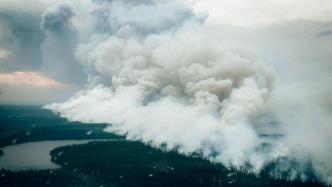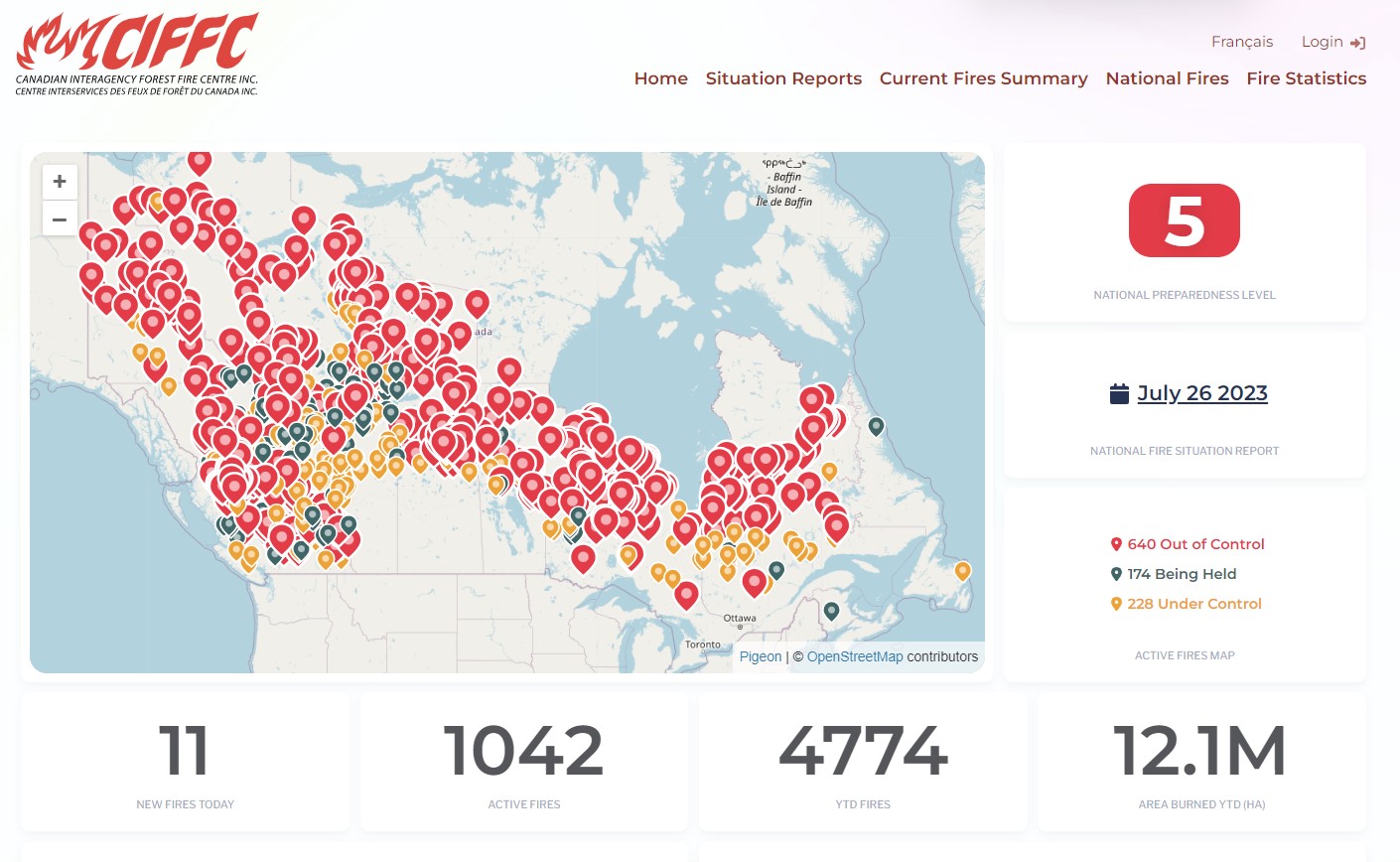

On July 14, 2023 local time, Quebec, Canada. Aerial images showed wildfire smoke engulfing a forest in the Northlands. Visual China Map
This year, Canada has suffered unprecedented wildfires. According to the latest data from the Canadian Forest Fire Center, as of July 26 local time, a total of 4,774 fires have occurred across Canada, with a cumulative fire area of over 121,000 square kilometers, exceeding the land area of South Korea (about 103,000 square kilometers). From 2000 to 2021, the cumulative area affected by forest fires is 7.5 times .

Canada’s cumulative fire area map, based on data from the Canadian Forest Fire Center https://ciffc.net/ and the Canadian Forest Fire Dataset https://cwfis.cfs.nrcan.gc.ca/ha/nfdb
On July 27, Beijing time, Liu Zhihua, a researcher at the Shenyang Institute of Applied Ecology of the Chinese Academy of Sciences, and Wang Zhe, an associate researcher at the Institute of Atmospheric Physics, disclosed in an interview with the media that the current carbon dioxide emissions from forest fires in Canada have reached 1 billion tons. Liu Zhihua said, "Greenhouse gases such as carbon dioxide, methane, and nitrous oxide emitted by Canadian forest fires have had a non-negligible impact on global warming and have developed into a global environmental event."

As of July 26, local time, a total of 4,774 fires had occurred across Canada, and the cumulative fire area had exceeded 121,000 square kilometers, exceeding the land area of South Korea.
Remote sensing technology is currently an effective means of estimating carbon emissions from large-scale forest fires. Based on the intensity of carbon release and the area burned by remote sensing observations, rapid assessment of carbon release from forest fires can be realized. According to expert estimates, as of now, the greenhouse effect of the methane and nitrous oxide emitted by the forest fires is equivalent to about 110 million tons of carbon dioxide equivalent, plus the direct emission of 1 billion tons of carbon dioxide, the greenhouse gas emissions of Canadian forest fires are equivalent to At 1.11 billion tons of carbon dioxide equivalent, it has exceeded Japan's annual energy-related carbon dioxide emissions in 2021 (according to the data of the International Carbon Plan, Japan's annual energy-related carbon dioxide emissions in 2021 will be 1.067 billion tons, ranking fifth in the world) . In addition, about one-eighth of Canadian forest fires occurred in permafrost areas, which promoted the release of methane stored in permafrost.

Local time July 10, 2023, British Columbia, Canada. Aerial footage of the Tatkin Lake wildfire. Visual China Map
In addition to emitting greenhouse gases and affecting the climate, forest fires in Canada cause environmental impacts and damage human health by releasing air pollutants such as PM2.5, PM10, organic aerosols, and black carbon. Up to now, there are four main cross-border transmission processes that have a greater impact, namely May 17-26, June 6-19, June 23-30, and July 15-20, all of which significantly reduced the number of U.S. Air quality (up to 50μg/m3 or more) has caused flight cancellations, school closures, and seriously disrupted production and living order. Among them, the second transmission process caused the most serious pollution weather in New York City since 1960. The third transmission process caused Chicago's air quality index to exceed the standard by 5.6 times on June 27.
PM2.5 released by forest fires in Canada is affected by westerly circulation and weather dynamics, resulting in long-distance cross-border transmission. It reached Scandinavia in Europe on May 25, spread to Iceland and Greenland on June 8, and spread to the European continent on June 26. The atmospheric transmission process from June 27 to 30 contributed more than 5 μg/m3 to PM2.5 in Europe. This transmission process also spread to North Africa and Asia, contributing about 1-2 μg/m3 to the PM2.5 concentration in western my country.
In addition, forest fires have a serious impact on forest ecosystems. Fast-burning forest fires have caused massive destruction and death of vegetation, not only causing biodiversity loss, but also causing animals to lose habitat and food sources. In addition, forest fires will also destroy the vegetation cover and expose the soil surface, thereby increasing the frequency of secondary disasters such as soil erosion, soil erosion, and landslides.
Such a large-scale forest fire has exceeded the scope of natural variability and evolved into a destructive disaster. Frequent and severe fires not only quickly deplete the carbon storage in vegetation and soil, but also change the natural succession of forests, degrading the ecosystem into shrubs or grasslands, seriously reducing the carbon sink function of the ecosystem. Therefore, large-scale forest fires destroy the balance of the ecosystem, rather than the ecological disturbance process as traditionally understood .
In recent years, with climate warming and the increasing impact of human activities, extreme forest fires have occurred frequently. For example, in the 2019 Amazon forest fire, the area burned in 10 months exceeded 90,000 square kilometers; in the 2019-2020 Australian fire, the area burned in one year 243,000 square kilometers. The fire season in Canada usually lasts until October. The forest fires are likely to continue to spread , and the scale of the disaster will further expand, continuing to refresh the country's historical records.
According to the "2022 China Land Greening Status Bulletin", my country's forest area is about 2.31 million square kilometers (about 2/3 of Canada's forest area), and the forest coverage rate is about 24.02%. Work presents great challenges. Over the years, the Chinese government has adhered to the policy of "combining prevention with prevention and rescue". Through the joint efforts of the whole society, it has accumulated rich experience in forest fire prevention and control, and successfully reduced the incidence of forest fires and disaster losses. The ability to prevent and control has been significantly improved. According to estimates, China's annual forest fire carbon dioxide emissions from 2000 to 2021 are about 15 million tons, accounting for only 0.2% of the global annual wildfire emissions , demonstrating China's responsibility as a major country.